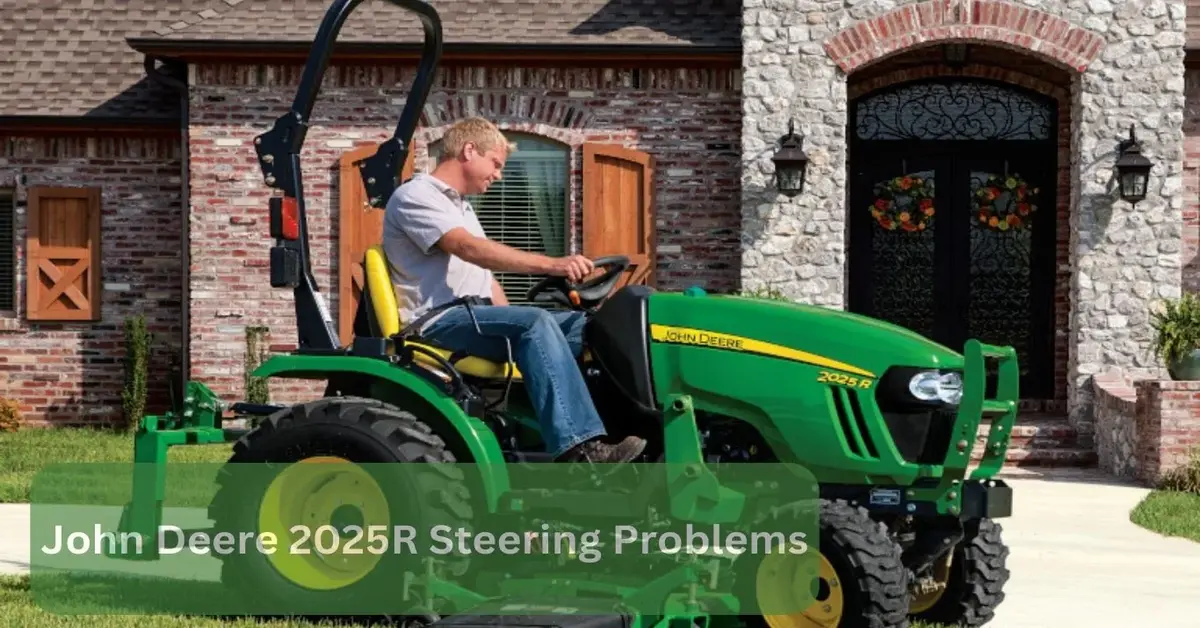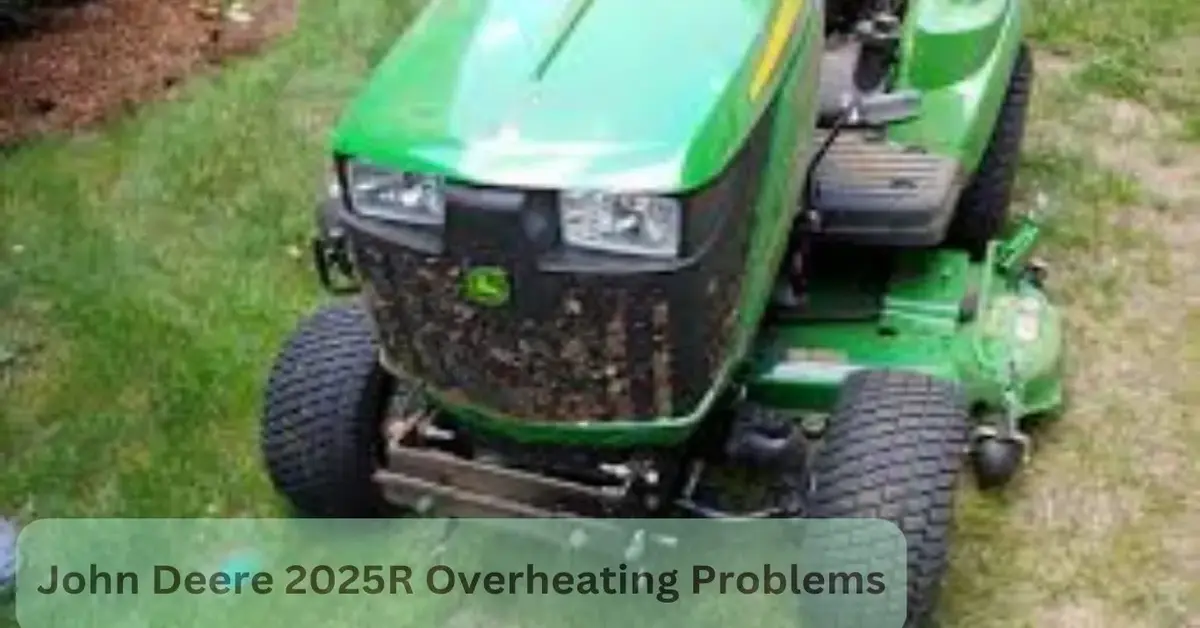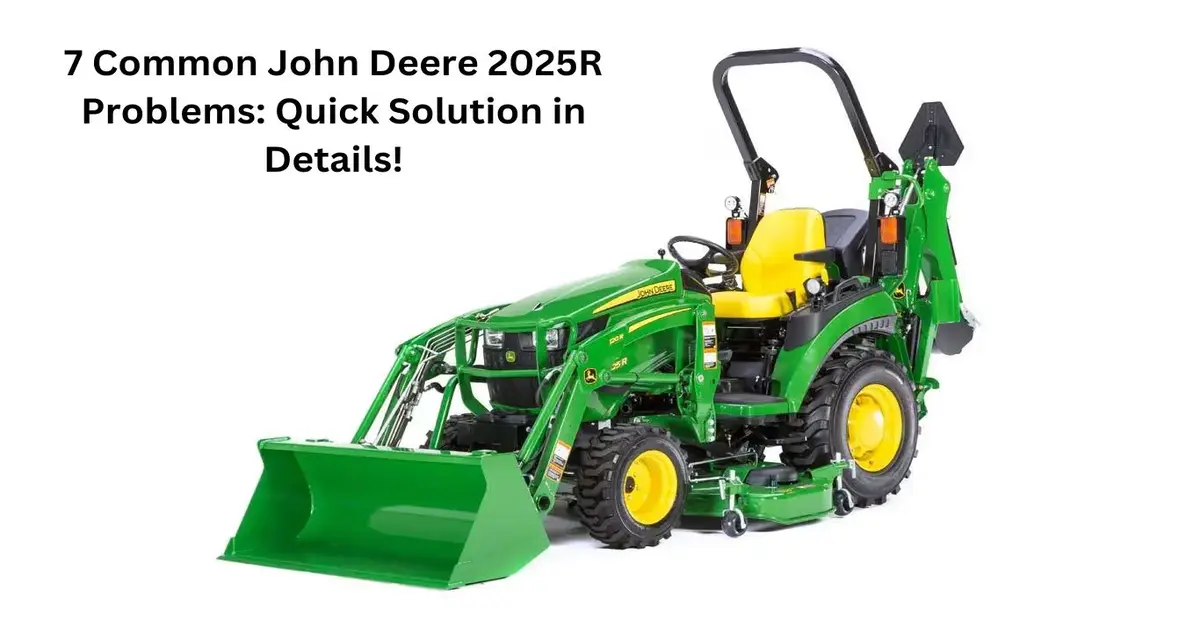The John Deere 2025R is a versatile and reliable compact utility tractor widely used in agricultural and landscaping operations. Known for its durability and performance, this tractor is a popular choice among farmers and property owners for various tasks, including mowing, tilling, hauling, and more.
Importance of Addressing Common Problems Promptly
Like any mechanical equipment, the John Deere 2025R is susceptible to occasional issues and malfunctions. While these problems can be frustrating, addressing them promptly is crucial to ensuring the continued efficiency and effectiveness of the tractor. Ignoring or neglecting common problems can lead to more significant issues down the line, resulting in costly repairs and downtime. Therefore, it’s essential for tractor owners to be aware of the common problems that may arise and know how to troubleshoot and resolve them quickly to minimize disruptions to their work. In this article, we’ll discuss seven common problems that John Deere 2025R owners may encounter and provide detailed solutions to help tackle them effectively. Let’s dive in!
Problem 1: Engine Won’t Start
Possible Causes
When your John Deere 2025R won’t start, it can be due to various reasons. Common culprits include fuel issues, such as running out of fuel or using stale fuel, and battery problems like a dead battery or corroded terminals. Other potential causes may include a faulty ignition switch or a clogged fuel filter.
Step-by-Step Troubleshooting Guide
- Check the Fuel Level: Ensure that there is enough fuel in the tank to power the engine. If the fuel level is low, refuel the tractor.
- Inspect the Battery: Check the battery connections for any signs of corrosion or loose connections. If necessary, clean the battery terminals and tighten the connections.
- Test the Ignition Switch: Turn the ignition key to the ON position and listen for any clicking sounds. If there is no response, the ignition switch may be faulty and need replacement.
- Examine the Fuel Filter: Inspect the fuel filter for any signs of clogging or contamination. If dirty, replace the fuel filter to ensure proper fuel flow to the engine.
- Attempt a Jump Start: If the battery is low, try jump-starting the tractor using jumper cables and another vehicle with a charged battery.
- Check for Spark: Remove the spark plug wire and check for spark by holding it close to a grounded metal surface while someone cranks the engine. If there is no spark, the ignition system may need to be inspected further.
Tips for Prevention
- Regularly check the fuel level and refill as needed to avoid running out of fuel.
- Keep the battery terminals clean and tight to ensure proper electrical connections.
- Replace the fuel filter at recommended intervals to prevent clogging and fuel flow issues.
- Store the tractor in a dry, sheltered area to protect the electrical components and prevent corrosion.
Read More: John Deere S220 Vs S240: Features and The Key Differences
Problem 2: Transmission Troubles
Symptoms of Transmission Issues
When your John Deere 2025R experiences transmission problems, you may notice several symptoms. These include difficulty shifting gears, strange noises coming from the transmission, grinding or shaking sensations while driving, and slipping gears where the tractor doesn’t move smoothly.
Steps to Diagnose and Fix Transmission Problems
- Check the Transmission Fluid: Start by inspecting the transmission fluid level and condition. Low or dirty transmission fluid can cause shifting problems. If necessary, top up or replace the fluid following the manufacturer’s recommendations.
- Inspect the Transmission Components: Look for any visible signs of damage or wear on the transmission components, such as the gears, clutch, and linkage. Replace any worn or damaged parts as needed.
- Adjust the Clutch: If the clutch is not engaging or disengaging properly, it may need adjustment. Follow the tractor’s manual to adjust the clutch to the correct specifications.
- Examine the Transmission Linkage: Check the linkage between the transmission and the gear shift lever for any looseness or misalignment. Tighten or realign the linkage as necessary.
- Test Drive the Tractor: Take the tractor for a test drive to assess how it performs. Pay attention to any unusual noises, vibrations, or difficulties in shifting gears. This will help identify any remaining issues that need to be addressed.
Maintenance Tips to Prevent Transmission Issues
- Regularly check the transmission fluid level and condition and replace it at recommended intervals.
- Avoid overloading the tractor beyond its capacity, as this can put extra strain on the transmission.
- Operate the tractor smoothly and avoid abrupt changes in speed or direction to reduce wear and tear on the transmission components.
- Keep the transmission and gear shift linkage well lubricated to ensure smooth operation. Lubricate according to the manufacturer’s recommendations.
Read More: John Deere 35D vs 35G: A Comprehensive Comparison
Problem 3: Hydraulic System Malfunctions
Signs of Hydraulic System Problems
When your John Deere 2025R experiences issues with its hydraulic system, there are several signs to watch out for. These include slow or unresponsive hydraulic functions, leaks or puddles of hydraulic fluid under the tractor, unusual noises such as whining or groaning when using hydraulic implements, and erratic movement of hydraulic components.
How to Check and Repair Hydraulic System Issues
- Inspect Hydraulic Fluid Level: Begin by checking the hydraulic fluid level in the reservoir. If it’s low, add the appropriate type of hydraulic fluid to the recommended level.
- Check for Leaks: Look for any visible leaks in the hydraulic lines, fittings, and seals. Tighten loose fittings and replace damaged or worn seals to prevent further leakage.
- Test Hydraulic Functions: Operate the hydraulic functions, such as the loader or three-point hitch, and observe their performance. Note any irregularities such as slow or jerky movement, which may indicate underlying issues.
- Inspect Hydraulic Filters: Check the hydraulic filters for any signs of clogging or contamination. Replace the filters if they are dirty to ensure proper flow of hydraulic fluid through the system.
- Bleed Air from the System: If air has entered the hydraulic system, it can cause sponginess or erratic behavior. Bleed air from the system following the tractor’s manual to restore proper hydraulic function.
Importance of Regular Hydraulic System Maintenance
- Regular maintenance of the hydraulic system is essential to ensure smooth and reliable operation of hydraulic functions.
- Check hydraulic fluid levels and condition regularly and top up or replace fluid as needed to prevent damage to hydraulic components.
- Inspect hydraulic lines, fittings, and seals for leaks and damage and address any issues promptly to prevent loss of hydraulic fluid and potential damage to the system.
- Replace hydraulic filters at recommended intervals to maintain optimal performance and prolong the life of hydraulic components.
- Follow the manufacturer’s recommendations for hydraulic system maintenance to keep your John Deere 2025R running smoothly for years to come.
Read More: John Deere 4 Series Vs 5 Series: Which Tractor is Right for You?
Problem 4: Electrical Glitches
Common Electrical Issues with the John Deere 2025R
When it comes to electrical problems with your John Deere 2025R, there are a few common issues that may arise. These include:
- Dead Battery: The battery may become discharged, preventing the tractor from starting.
- Faulty Wiring: Damaged or frayed wiring can cause electrical shorts and malfunctions.
- Failed Starter Motor: A malfunctioning starter motor can prevent the engine from cranking.
- Blown Fuses: Blown fuses can interrupt the flow of electricity to vital components, leading to system failures.
- Ignition Switch Problems: Issues with the ignition switch can prevent the tractor from starting or cause intermittent electrical problems.
Troubleshooting Steps for Electrical Problems
- Check the Battery: Begin by checking the battery voltage using a multimeter. If the voltage is low, recharge or replace the battery as necessary.
- Inspect Wiring: Inspect the wiring harness for any signs of damage or corrosion. Replace any damaged wires and ensure all connections are secure.
- Test the Starter Motor: Use a multimeter to test the starter motor for continuity. If the motor fails the test, it may need to be replaced.
- Check Fuses: Inspect all fuses in the tractor’s electrical system and replace any that are blown with fuses of the correct amperage.
- Test the Ignition Switch: Test the ignition switch for proper operation using a multimeter. Replace the switch if it is faulty.
Preventive Measures for Electrical System Maintenance
- Regularly inspect the battery terminals for corrosion and clean them if necessary to ensure good electrical connections.
- Keep the wiring harness and electrical components clean and free from dirt and debris to prevent damage and corrosion.
- Store the tractor in a dry, sheltered location to protect the electrical system from moisture and humidity.
- Follow the manufacturer’s recommended maintenance schedule for the electrical system, including battery checks and replacements as needed.
- Address any electrical issues promptly to prevent further damage and ensure the continued reliability of your John Deere 2025R.
Read More: John Deere ATU 200 Vs 300: Which is the right fit for your farm?

Problem 5: Steering Difficulties
Symptoms of Steering Problems
When your John Deere 2025R experiences steering difficulties, there are several signs you may notice:
- Hard Steering: The steering wheel may feel stiff and require more effort to turn.
- Loose Steering: Alternatively, you may experience excessive play or looseness in the steering wheel.
- Uneven Steering: The tractor may pull to one side or drift while driving, indicating alignment issues.
- Strange Noises: You might hear clunking, clicking, or grinding noises when turning the steering wheel, suggesting potential mechanical issues.
Solutions for Addressing Steering Difficulties
- Check Tire Pressure: Start by ensuring that the tire pressure is correct according to the manufacturer’s recommendations. Low tire pressure can affect steering responsiveness.
- Inspect Steering Components: Check the steering linkage, tie rods, and steering gearbox for any signs of damage or wear. Replace any worn or damaged parts to restore proper steering function.
- Adjust Steering Alignment: If the tractor pulls to one side or has uneven steering, it may need a wheel alignment. Follow the manufacturer’s specifications to adjust the steering alignment properly.
- Lubricate Steering Components: Lubricate the steering linkage and other steering components to reduce friction and improve steering smoothness.
- Check Power Steering Fluid: If your tractor is equipped with power steering, check the power steering fluid level and top up if necessary. Low fluid levels can cause steering difficulties.
Tips for Maintaining Proper Steering Functionality
- Regularly inspect the steering components for signs of wear and damage, and address any issues promptly.
- Avoid driving over rough terrain or obstacles that could damage the steering system.
- Perform regular maintenance, including lubricating steering components and checking alignment, to ensure optimal steering performance.
- If you notice any unusual steering behavior, such as stiffness or looseness, have it inspected by a qualified technician to prevent further damage.
Read More: The Definitive Guide to Choosing Between John Deere S240 and X350 Lawn Tractors
Problem 6: PTO (Power Take-Off) Failure
Causes of PTO Failure
When the Power Take-Off (PTO) system of your John Deere 2025R fails, it can be due to several reasons:
- Overloading: Putting too much strain on the PTO system by attaching heavy implements or operating them at high speeds can lead to failure.
- Lack of Lubrication: Insufficient lubrication of PTO components can cause excessive wear and tear, failing over time.
- Mechanical Issues: Damage or wear to PTO shafts, gears, or bearings can cause the system to malfunction.
- Electrical Problems: Issues with electrical components such as the PTO switch or wiring can prevent the PTO from engaging or disengaging properly.
Steps to Troubleshoot and Repair PTO Issues
- Inspect PTO Components: Start by visually inspecting the PTO shaft, gears, and bearings for any signs of damage or wear. Replace any worn or damaged parts as needed.
- Check PTO Engagement: Test the PTO engagement mechanism to ensure it is functioning correctly. This may involve checking the PTO switch, wiring, and safety interlocks.
- Verify Lubrication: Make sure that the PTO components are properly lubricated according to the manufacturer’s recommendations. Add lubricant if necessary to prevent further damage.
- Test PTO Operation: Engage the PTO and observe its operation. Listen for any unusual noises or vibrations that may indicate underlying issues.
- Consult the Manual: Refer to the tractor’s manual for troubleshooting tips and specific repair procedures. Follow the recommended steps to diagnose and repair PTO problems effectively.
Regular Checks to Prevent PTO Failure
- Inspect PTO Components: Regularly inspect the PTO shaft, gears, and bearings for signs of wear and damage. Replace any worn or damaged parts promptly to prevent failure.
- Lubricate Regularly: Ensure that the PTO components are adequately lubricated at recommended intervals to reduce friction and wear.
- Avoid Overloading: Use implements that are within the recommended capacity of the tractor’s PTO system to prevent an overloading and potential failure.
- Follow Proper Operating Procedures: Operate the PTO system according to the manufacturer’s guidelines to prevent damage and ensure longevity.
- Perform Regular Maintenance: Schedule regular maintenance checks for your John Deere 2025R, including inspections of the PTO system, to catch any potential issues early and prevent failure.
Read More: John Deere Won’t Move Forward or Reverse

Problem 7: Overheating
Signs of Overheating in the John Deere 2025R
When your John Deere 2025R is overheating, there are several signs to watch out for:
- High-Temperature Gauge: The temperature gauge on the tractor’s dashboard may show a reading in the red zone, indicating that the engine is running too hot.
- Steam or Smoke: You may see steam or smoke coming from the engine compartment, which is a clear sign of overheating.
- Loss of Power: The tractor may lose power or become sluggish as a result of the engine overheating.
- Coolant Leaks: Coolant leaks under the tractor or around the radiator hoses and connections can indicate overheating issues.
How to Prevent and Address Overheating Problems
- Check Coolant Level: Regularly check the coolant level in the radiator and top it up if necessary. Low coolant levels can lead to overheating, so it’s essential to maintain the proper fluid level.
- Inspect Radiator and Hoses: Inspect the radiator and radiator hoses for any signs of damage or leaks. Replace any damaged hoses or repair leaks to prevent coolant loss and overheating.
- Clean Radiator Fins: Dirt, debris, and bugs can accumulate on the radiator fins and block airflow, leading to overheating. Clean the radiator fins regularly to ensure proper cooling.
- Check Thermostat: A faulty thermostat can cause the engine to overheat. Test the thermostat for proper operation and replace it if necessary.
- Monitor Engine Load: Avoid overloading the tractor or operating it at high speeds for extended periods, as this can put extra strain on the engine and cause overheating.
Importance of Proper Cooling System Maintenance
- Regular maintenance of the cooling system is crucial to prevent overheating and ensure the reliable operation of your John Deere 2025R.
- Overheating can cause significant damage to the engine and other components, resulting in costly repairs and downtime.
- Proper cooling system maintenance, including checking coolant levels, inspecting hoses and connections, and cleaning the radiator, can help prolong the life of your tractor and keep it running smoothly.
- By following the manufacturer’s recommended maintenance schedule for the cooling system, you can avoid overheating problems and enjoy reliable performance from your John Deere 2025R for years to come.
Read More: John Deere Tractor Won’t Move Forward or Reverse
Conclusion
In conclusion, the John Deere 2025R is a reliable tractor, but like any piece of machinery, it can experience common problems. By being aware of these issues and knowing how to address them, you can keep your tractor running smoothly and efficiently.
From engine starting troubles to steering difficulties and overheating concerns, we’ve discussed seven common problems and provided quick solutions to tackle them effectively. Remember to regularly check and maintain your tractor, including its engine, transmission, hydraulic system, electrical components, steering, PTO system, and cooling system.
By following preventive maintenance measures and addressing any issues promptly, you can minimize downtime and costly repairs, ensuring that your John Deere 2025R remains a dependable workhorse for your agricultural or landscaping needs.
Keep these solutions in mind, and you’ll be better equipped to handle any challenges that may arise with your John Deere 2025R, keeping it running smoothly for years to come.
